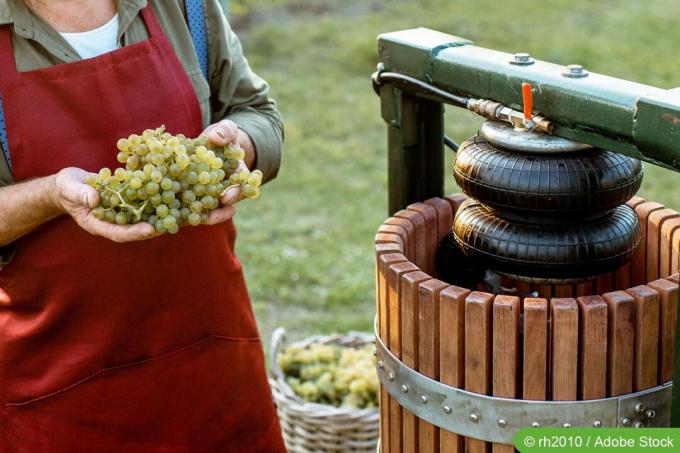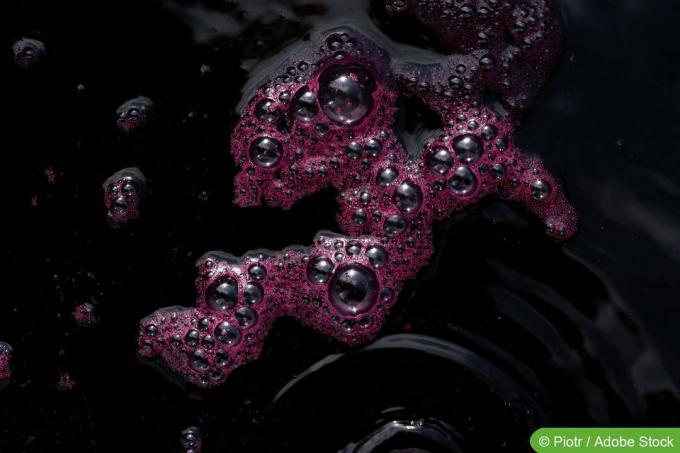

Table of contents
- acidity
- Red or white wine?
- Instructions
There are vines in many gardens today and the yields are often not bad at all. That tempts some garden owners to take a look home made wine to try.
In principle, it is not difficult at all if you stick to a few rules.
When making wine from grapes, it is extremely important that the grapes are very ripe. Grape wine must also never be diluted with water, as this would totally water down the wine.
acidity
In our latitudes, the location and the weather are often not ideal for grapes. Therefore, their acidity is usually not ideal. Usually it has too high an acid content. Once the acid loss is too high, it is quite easy to acidify the wine. Citric or lactic acid is used. However, this is very rare in our areas.
To ensure that wine made from grapes does not taste sour and has a sufficient shelf life, the grape juice should have 6-9 grams of acid per liter and a must weight of at least 85ËšOechsle. You should be very precise with the measurement, because the sugar and acid values of the grapes can vary greatly. If you know the exact values, you can make appropriate corrections, i.e. deacidification and added sugar.
Red or white wine?
There is a significant technological difference between the production of red and white wine. The coloring of red grapes is almost always fixed in the grape skin. So you can't press a red mash like a white one after a short standing time, because it would be completely colorless. In order to achieve the red color, the mash must either be heated or subjected to mash fermentation.
Instructions
After the grape harvest, the stems are first removed from the fruit. The berries are then crushed to create the mash.
- White grape mash is enzymated to break down the pectin, sulphurized and left covered for a few hours before the juice is pressed. There are appropriate means for enzyming and sulfuring in cooperative markets such as the Raiffeisen markets and others.
- Red grape mash must be subjected to mash fermentation or mash heating. During heating, the mash is heated to 85 ËšC and then cooled again. Enzymation takes place at 50 ËšC. When the mash has cooled to room temperature, the juice is squeezed out and sulphurised.
The squeezed juice of both grape varieties is clarified by sieving or draining after a settling period.
The acidity and the must weight are checked using the Öchsle acid test. If the juice has to be deacidified, i.e. if it has more than 9g of acid per liter, wine deacidification lime is used. 0.7g of lime per liter reduces acidity by 1g/l. On the other hand, if the wine has to be improved, i.e. if the juices have a must weight of less than 85ËšOe, the value must be increased. Household sugar is used for this. 2.5 g of sugar per liter increase the must weight by 1 ËšOe.
When you have the optimal juice, it is filled into a fermentation tank. Add pure cultured yeast (according to package instructions). Now you can leave the beginning of the fermentation.
The fermenter must never be completely filled. About 10 percent are left free. The vessel is closed with a fermentation lock with tubes. The temperatures inside the container should be between 10 and 20 ËšC.
As soon as no more carbon dioxide formation can be seen, the fermentation is complete. The young wine is removed from the lees about 2 weeks later. It is best to sulphurize it at the same time. The wine is left to secondary fermentation and self-clarification in the tank filled with a bung.
After 6 to 8 weeks, the wine is drawn off a second time. If necessary, it must be fined and/or filtered. Fining means that wine that is not entirely clear is clarified with cold-soluble gelatine or silica sol.
The now finished wine is bottled, preferably in glass bottles that can be properly closed.
 garden editorial
garden editorial I write about everything that interests me in my garden.
Learn more about making wine yourself

Build a DIY wine trellis: climbing aid for grapevines
Grapevines are decorative and also suitable for harvesting usable fruit in private gardens. In order for this to succeed, the plant needs a trellis on which the shoots can climb up to the sun. With our instructions you can build your own trellis in no time at all.

Prepare wine yeast | Make pure culture yeast yourself
If you want to make fruit wine in your own cellar, you definitely need yeast. Only the wine yeast causes the mash to ferment. Such a fermentation yeast is relatively easy to prepare yourself. How exactly this works and what you should pay attention to is explained here.

Wine yeasts: overview of pure yeast varieties and prices
Wine does not always have to find its way to us from the wine shop or supermarket. He can also develop directly in our home. Wine yeast turns grapes and other fruit into wine in a matter of days. It's very easy for everyone.

Make wine yourself without yeast - yeast-free alcohol - instructions
Like many things, wine can also be made by yourself. In grandmother's time, this was also possible without yeast, although the wine was not always tasty. But even today, the wine can be prepared without yeast, although the question of success arises.

Winemaking at home - recipes
Making wine at home is not difficult at all. Fruit wines in particular are easy to make. Fruit wine should not be intoxicating, it should be a light refreshing drink.

Make & produce berry wine yourself
Berry wines made from grapes, raspberries, currants or other berries are quite easy to make. It is important that the fruit is ripe and healthy.



